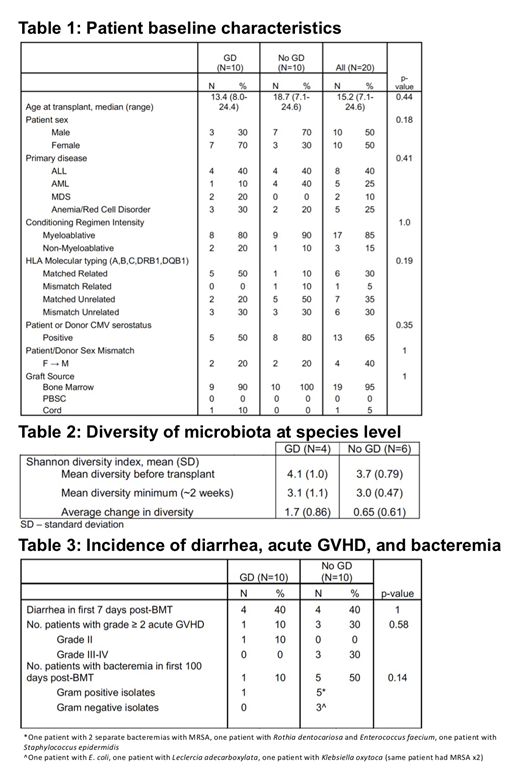Introduction: Early preclinical studies demonstrating that eradication of intestinal bacteria could prevent the development of acute graft-versus-host disease (aGVHD) after allogeneic hematopoietic stem cell transplantation (HSCT) led many adult and pediatric HSCT programs to practice "gut decontamination" (GD) with non-absorbable oral antibiotics for aGVHD prophylaxis. However, there is insufficient data supporting a clear benefit for GD in HSCT patients. Recent adult HSCT studies show that GVHD-related mortality is associated with decreased bacterial diversity in the gut microbiome, suggesting that certain bacterial species are protective against aGVHD. GD may decrease microbiome diversity and lead to worse post-HSCT outcomes.
Methods: We conducted a randomized phase 2 study to examine the impact of GD on intestinal microbiome composition in pediatric allogeneic HSCT patients. 20 patients were enrolled and randomized to receive (GD) or not receive (no GD) oral vancomycin-polymyxin per our institutional standard from day -5 through engraftment. Stool samples were collected pre-transplant, weekly until neutrophil engraftment, monthly through day +100, then at 6 months and 1-year post-HSCT. Our primary endpoint is bacterial diversity, quantified by Shannon diversity index, at 2 weeks post-HSCT. Change in diversity is defined as the delta of diversity before transplantation compared to the minimum diversity seen in a single patient in a one-week window (around 14 days post-transplantation). This change in diversity was then averaged (mean) across each treatment arm. The stool microbiome was characterized using shotgun metagenomic sequencing (Nextera Tagmentation and Illumina HiSeq4000 Sequencing) for 10 patients to date, with median count of 1.4x107 reads per sample (range 1.3x106 to 3.3x107). Following quality control (FastQC, Trim Galore, Super Deduper), reads are assigned taxonomic designations using Kraken2 and GenBank (Oct. 2018) database. Secondary endpoints include the frequency of diarrhea (defined as >3 bowel movements per day in the first 7 days post-HSCT), incidence of aGVHD and bacteremia during the first 100 days post-transplant, immune reconstitution, survival, and malignant disease relapse at 2 years after study entry. Comparisons by treatment group were performed with Fisher's exact test (binary) or Wilcoxon rank-sum test (continuous).
Results: Baseline patient characteristics were similar between the two arms (Table 1). At present,5 patients (25%) have completed 2 years of follow up, 4 of 15 patients with malignant disease (27%) have had relapse (3 GD, 1 No GD), and 2 patients (10%) in the No GD arm have died (1 malignant relapse, 1 refractory chronic GVHD). Microbiome analysis in the first 10 patients (4 GD, 6 No GD) demonstrates that the average change in Shannon diversity score at 2 weeks is 1.7 (SD 0.86) in GD and 0.65 (SD 0.61) in No GD (Table 2). Diarrhea occurred in 4/10 patients in GD vs 4/10 patients in no GD (p≥0.99).1/10 patients in GD and 3/10 in No GD developed aGVHD grade II or above(p=0.58). Bacteremia within the first 100 days post-HSCT occurred in 1/10 patient in GD, whereas 5/10 patients in No GD had 8 different bacteremia events (p=0.14) (Table 3).
Conclusions:
This is the first randomized study of gut decontamination in pediatric patients undergoing HSCT with long-term prospective post-transplant stool sample collection and immune monitoring. Though the small sample size is currently not powered to detect differences in clinical outcomes between the 2 study arms, the descriptive microbiome and immune reconstitution data will inform larger studies. There is no statistical difference in the diarrhea, aGVHD, or bacteremia incidence between the two groups but it is interesting that there was 1 vs 8 bacteremia events in GD vs No GD. Microbiota diversity results from our pilot study with 10 patients indicate a trend toward lower diversity at 2 weeks post-transplant in the GD arm. Microbiome analysis of the remaining samples from the remaining 10 patients is underway as well as longitudinal analysis of samples from all patients. Describing the changes to the microbiota composition over time in two groups will provide insight to practice of GD, potential targets for aGVHD, and will provide preliminary data to understand which microbes and microbial gene-pathways may influence immune reconstitution.
London:United Therapeutics: Consultancy; ArQule, Inc: Consultancy. Ritz:Draper Labs: Consultancy; Kite Pharma: Research Funding; Avrobio: Consultancy; LifeVault Bio: Consultancy; Merck: Research Funding; TScan Therapeutics: Consultancy; Talaris Therapeutics: Consultancy; Celgene: Consultancy; Aleta Biotherapeutics: Consultancy; Equillium: Research Funding. Bhatt:ArcBio: Other: Scientific Advisory Board; January.ai: Other: Scientific Advisory Board; Caribou Bioscience: Other: Scientific Advisory Board; Kaleido Biosciences: Consultancy, Other: Paid Consultant; Janssen Human Microbiome Institute: Consultancy, Other: Paid Consultant; Illumina: Honoraria; 10x Genomics: Other: Research collaboration without funding support; Illumina: Other: Research collaboration without funding support; Agilent: Research Funding; Global Oncology, Inc: Other: Nonprofit Board.
Author notes
Asterisk with author names denotes non-ASH members.


